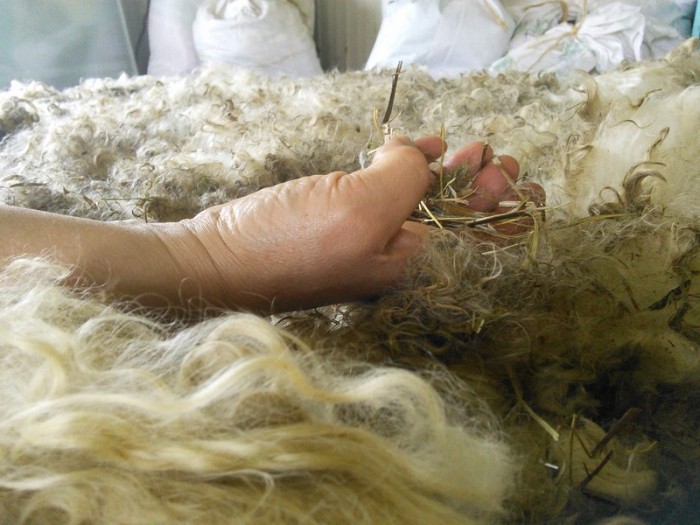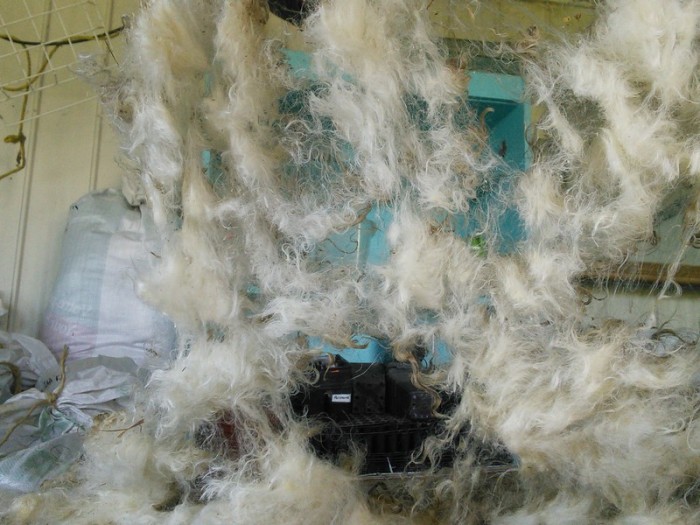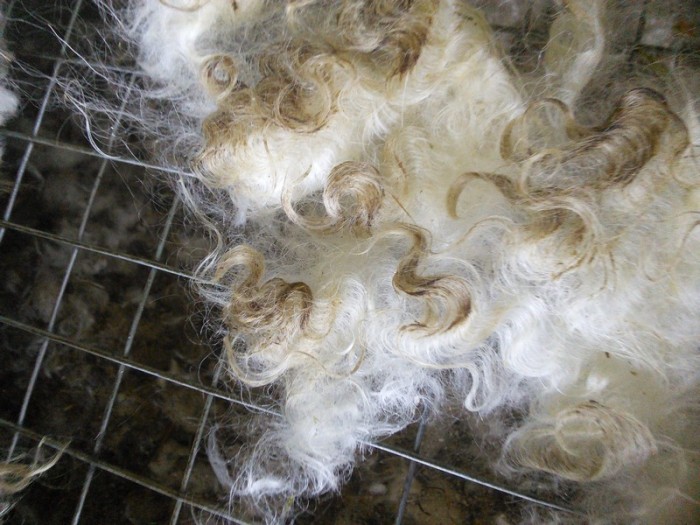In the post Shearing Time we showed you how we shear our goats, and in this post we continue our fibre journey.
Skirting (or sorting) The Fibre:
After shearing, the next step is skirting (the process of removing sections of the fleece which are dirty, coarse, or contaminated ). My technique continues to improve (there is always more to learn).
This is a crucial step that insures the quality of our fibre products such as our mohair locks, rovings and yarn. It’s a long process but necessary before the locks can be washed or the fleece sent to the fibre mill.
So after our goats are shorn, their fleeces are hung up in the barn in individual bags. Each bag is labelled with the animal’s name (or ear’s tag number), year of the shearing and type of fleece: kid, yearling, young adult or adult.
The skirting room
 This is my skirting room with my skirting table that my husband built for me. It’s a rectangular frame covered with a 1” mesh, which allows the ends and shorter cut pieces to fall through into the bottom of the box.
This is my skirting room with my skirting table that my husband built for me. It’s a rectangular frame covered with a 1” mesh, which allows the ends and shorter cut pieces to fall through into the bottom of the box.  I will use 5 bags to sort each fleece into: a hay bag, a urine bag, a coarse bag, a garbage bag and finally the mohair bag. I can hang all my sorting bags around the table which makes things much easier. The mohair will be kept separate: kid, yearling, young adult or adult depending on the age of the goat the fleece came from.
I will use 5 bags to sort each fleece into: a hay bag, a urine bag, a coarse bag, a garbage bag and finally the mohair bag. I can hang all my sorting bags around the table which makes things much easier. The mohair will be kept separate: kid, yearling, young adult or adult depending on the age of the goat the fleece came from.
In this post, we will skirt an adult fleece.
1. The fleece is taken out of the bag,
then laid out like a pelt with the dirty, greasy side up.
This step is why a good shearer is so important. It helps that ours shears our goats well and keeps their fleeces in one piece.
2. As you can see, there is a lot of vegetation matter (VM) like hay and straw.
 here is more in winter fleeces (which these are).
here is more in winter fleeces (which these are).  I remove as much vegetation as I can at this stage.
I remove as much vegetation as I can at this stage.
3. I usually completely remove the topline, head and bib because there is a lot of VM in those parts.
 They go straight into the hay bag. It would take far too long to sort it. Here you see an example of the amount of vegetation that can be found in this part of the fleece.
They go straight into the hay bag. It would take far too long to sort it. Here you see an example of the amount of vegetation that can be found in this part of the fleece. 
 I also remove all the fibre contaminated by manure and it goes into the garbage bag. Fleece contaminated by urine has its own bag. What I call the hay, coarse and urine bags will go to a wool cooperative later in the summer.
I also remove all the fibre contaminated by manure and it goes into the garbage bag. Fleece contaminated by urine has its own bag. What I call the hay, coarse and urine bags will go to a wool cooperative later in the summer.
4. Once this is done, I make room on my table, take a piece of fleece and work with it.

First I shake it to allow any second cuts (the little pieces of fleece that result from the shearer going a second time over the same area), dust, bugs or anything else that has got caught in it to fall out through the mesh.
5. I continue to remove all the VM I can find.  What seems to damage the fleeces most is the timothy hay and burdock burrs because they get caught Inside the locks and the seeds become embedded in the fibre.
What seems to damage the fleeces most is the timothy hay and burdock burrs because they get caught Inside the locks and the seeds become embedded in the fibre. So when you want to get rid of them you need to remove a large amount of fibre.
So when you want to get rid of them you need to remove a large amount of fibre.
6. Next, I sort the locks.
Some are coarser and will go in the coarse bag.
 Here are some locks with nice crimps and good length, they will go in the adult bag.
Here are some locks with nice crimps and good length, they will go in the adult bag.

 What is in this bag will be used to make rovings and yarn, and I will keep some to wash and dye. (Dying will be the subject of another post.)
What is in this bag will be used to make rovings and yarn, and I will keep some to wash and dye. (Dying will be the subject of another post.)
Here you see parts from different fleeces:
In general, my angora goats have an average length of 6 to 8 cm. 

 Some have long curly locks
Some have long curly locks

while others have a medium crimp in their locks.
 Usually the better part of the fleece is on the back (barrel) area.
Usually the better part of the fleece is on the back (barrel) area.
Kids fleeces are generally more difficult to skirt as their hair is like velcro.
This is an over view of how I sort my angora goat fleece.
For alpacas and llamas it is a similar process.
As you can see before the fibre is washed or processed a lot of labour goes into preparing it. By the time this step is completed the weight of the fleece has been reduced by one third up to a half. No matter which method is used to process the fibre we will lose even more of it while it is being made in to rovings or yarn, or washed to be used as locks. (One way we use our beautifully soft locks after washing is to make gorgeous big powder puffs!)
As we mentioned dying is the next step and this is the season when we dye our locks and yarn. We are always interested in knowing your opinions so if anyone would like to suggest colours they would particularly like to see we’d be happy to hear from you. And we are happy to see your questions or comments!
Note:
Contest Winners!
Congratulations to Helen Marie and Heart Felted And Clay, the two winners of our contest! We will be contacting you privately to arrange for the delivery of your prizes. Thank you to everyone who entered!






Just amazing! I learned so much!!! So much work and care goes into preparing the fibers. I definitely have so much more appreciation for the process. Thank you for sharing this!
LikeLike
Dear heartfeltedandclay,
Thank you so much for stopping by and for your very kind comment! We greatly appreciate being followed by such an amazing felter and artist. We hope to hear from you again and any thoughts and suggestions are always welcome.
Sincerely,
Isabelle
LikeLiked by 1 person
I have had a fleece sitting in paper bags for over a year. I decided to pull,it out but got very discouraged as to whether it was worth skirting it. I am new to this and don’t really know what quality the fleece should be in when I start. It looked a mess to me so I gave up. My goat is a coloured angora. It seems to be in much worse shape than my Shetland sheep. Thoughts??
LikeLike
Hi Judy, Thanks for writing us concerning your fleece. I will try to help you with this. The first thing I look on a fleece is if the locks are breakable or not when you pull them between your fingers. If they don’t break, well your fleece might be good. Remove all the manure and the parts where there are too much vegetation. And well, after that this is a question of time, patience and a lots of hours: this is really a long job.
I just tried the fermented suint method (used on sheep fleeces) to clean a fleece but it doesn’t look it will work on Angora Goats. No enough grease on the fleeces!!!
LikeLike